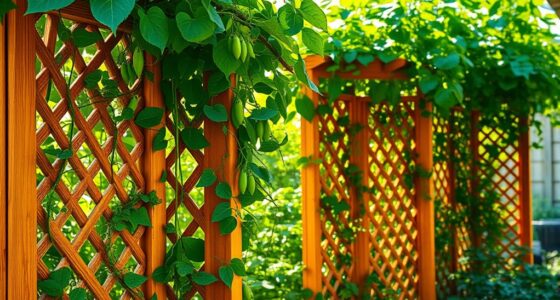To create a DIY vertical pallet garden for your balcony, select a sturdy, untreated pallet and modify it by removing unnecessary slats for open planting spaces. Secure breathable landscape fabric inside to form pockets, then fill them with nutrient-rich, well-draining soil. Arrange your plants based on water needs and place them in the pockets. Finish with weather-resistant paint and mulch to retain moisture. For tailored tips and step-by-step guidance, keep exploring how to assemble your perfect green oasis.
Key Takeaways
- Select untreated, heat-treated pallets with slatted design for easy fabric attachment and airflow.
- Secure landscape fabric inside the pallet to create soil pockets with proper drainage.
- Reinforce the structure and modify slats to fit your balcony space securely.
- Fill with nutrient-rich, well-draining soil suitable for shallow-rooted plants.
- Arrange lightweight plants with similar needs, and ensure proper watering and pest control.
Selecting the Perfect Pallet for Your Garden
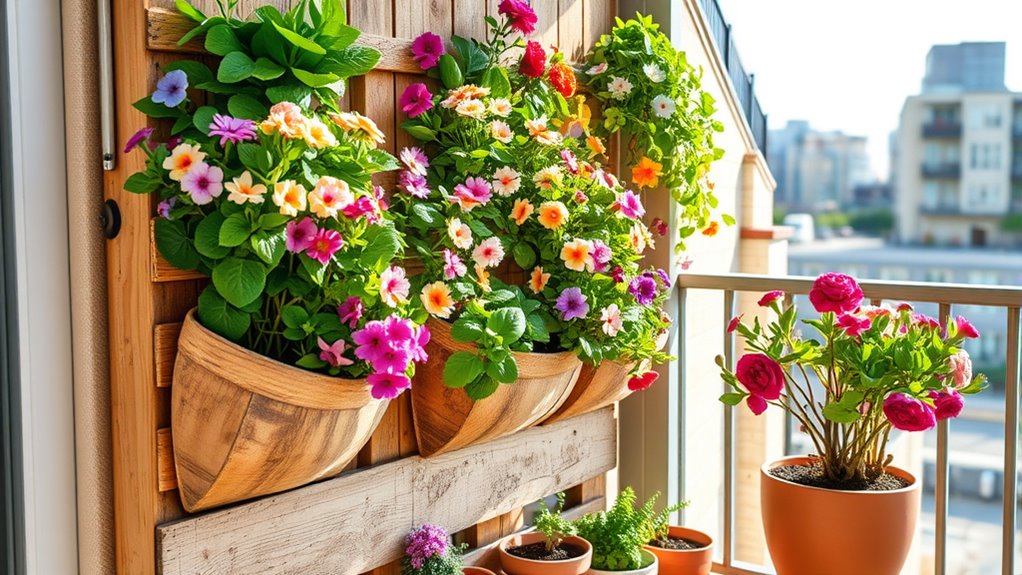
When choosing a pallet for your vertical garden, it’s essential to select one made from untreated, either hardwood or softwood, to prevent chemical contamination. A safe pallet garden starts with inspecting the wood for mold, damage, or splinters.
Make sure the pallet is heat-treated, marked with “HT,” rather than chemically treated, which is labeled “MB” or “DB.” This guarantees no harmful chemicals will leach into your plants.
Check for protruding nails, broken slats, or splinters that could harm your plants or pose safety risks.
The size of the pallet should fit your space, usually around 40-48 inches wide for a standard garden pallet.
Prefer pallets with a slatted design, making it easier to attach landscape fabric and promoting good airflow for healthy root growth.
Ensuring the pallet is free from chemical treatments helps maintain a safe environment for your plants and aligns with best gardening practices. Additionally, selecting a pallet with adequate drainage is crucial to prevent excess moisture and promote healthy plant growth. Incorporating proper ventilation can further enhance airflow and reduce the risk of mold or rot within your vertical garden.
Preparing and Modifying Your Pallet Structure
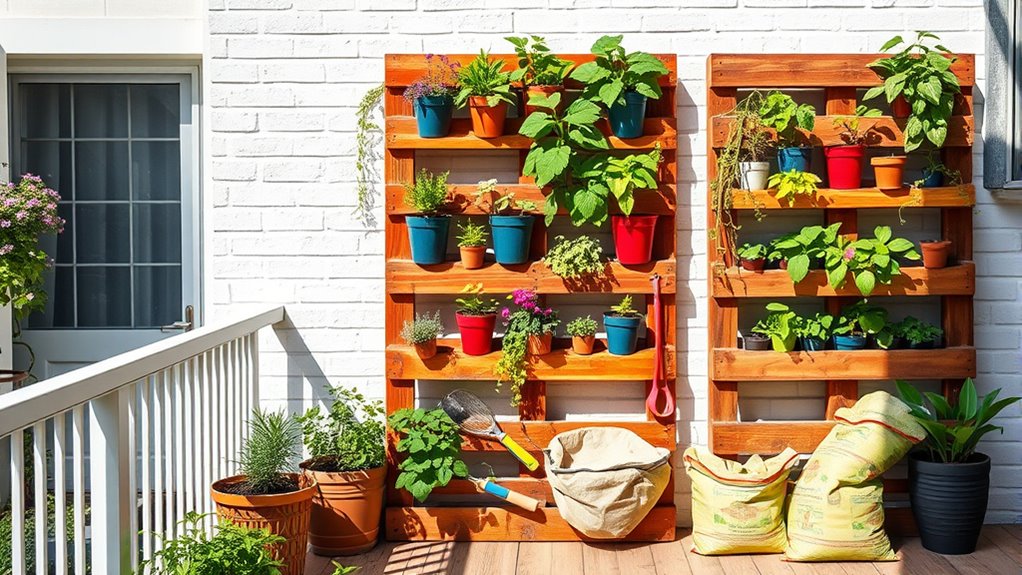
Start by removing any unnecessary slats with a hammer and pry bar to create open spaces for your plants.
Then, cut landscape fabric to twice the length of the pallet, fold it in half, and attach it securely with a staple gun along the back.
Make sure to pull the fabric taut, forming pockets deep enough to hold soil and promote proper drainage. Proper drainage is essential for healthy plant growth and avoiding waterlogging.
For extra stability, consider reinforcing the structure with additional supports similar to how lightweight yet durable materials are designed with performance in mind to enhance stability.
Additionally, incorporating security measures can help protect your garden from theft or vandalism, especially if your balcony is accessible to others.
Implementing proper anchoring techniques can further prevent the pallet from shifting or tipping over due to wind or movement.
Removing Unnecessary Slats
Carefully removing unnecessary slats from your pallet is essential to creating a functional vertical garden. Use a hammer and pry bar to gently detach slats that won’t support planting pockets. Focus on those that are loose or damaged, and remove nails or staples to prevent injury and make disassembly easier. Keep the slats organized, as you might reuse them as feet or braces later. Proper maintenance and careful handling can extend the life of your pallet structure. Guarantee the wood is clean and free of splinters before storing. Discard any warped or broken slats to maintain your pallet’s stability. Take your time during this process to avoid splitting the wood, which could compromise your vertical garden’s structure. Properly modifying your pallet by removing unnecessary slats sets a solid foundation for a successful DIY project.
Securing Fabric and Soil
To prepare your pallet for planting, cut strips of porous landscape fabric into lengths twice the width of the pallet. Fold these strips and staple them onto the back, forming pockets for your potting soil. Using a durable, breathable material helps prevent soil from escaping and promotes healthy root growth. Pull the fabric taut to add slack, ensuring it can hold enough soil for healthy plant roots while allowing water to drain freely. Make the pockets deep enough to contain ample soil, supporting strong plant growth. Use a staple gun to secure the fabric along the sides and bottom of each cavity, preventing soil from falling out. Additionally, selecting high-quality drainage materials can further enhance water flow and prevent root rot. Incorporating proper watering techniques can also help maintain optimal moisture levels within the soil-filled pockets. Remember that attention to detail during assembly ensures your vertical garden will be both functional and aesthetically pleasing. Visualize your pallet with fabric pockets brimming with potting soil, ready to host vibrant plants.
- Picture soil-filled pockets, evenly spaced and ready for planting
- Imagine water draining effortlessly through the porous fabric
- Envision roots growing freely within the soil-filled cavities
Applying Protective and Decorative Paints
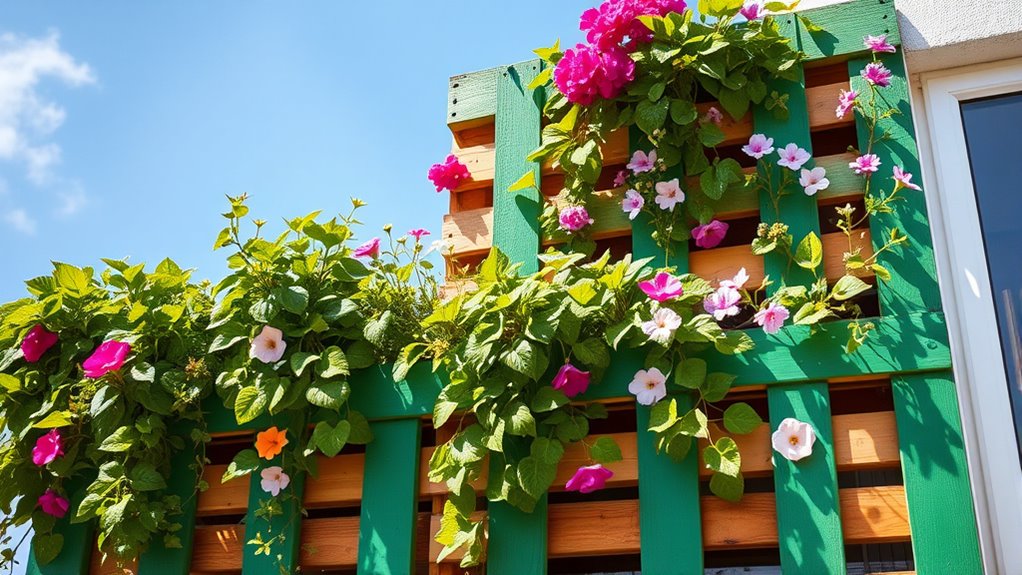
Applying protective and decorative paints is a essential step to guarantee your pallet garden withstands the elements while looking attractive. Start by lightly sanding the pallet to improve paint adhesion and achieve a smooth finish. Incorporating proper preparation techniques can further enhance the longevity of your paintwork and overall project success. Additionally, choosing the right type of paint, such as indoor/outdoor spray paint, ensures durability against weather exposure. Using weather-resistant paints can offer additional protection, especially in climates with high humidity or frequent rain.
Use gray indoor/outdoor spray paint as a base coat to provide a durable, weather-resistant surface. Once dry, add visual interest by applying leftover blue and black spray paints, creating depth and a unique decorative look. Exploring popular animated movies can inspire your creative design choices for decorating your pallet.
To achieve clean lines or patterns, use painter’s tape for precise designs. Confirm the paint is completely dry before planting to prevent soil contamination or paint transfer. Incorporating protective paints ensures your pallet remains resilient against weather and wear over time.
This finishing touch not only protects your pallet but also enhances its aesthetic appeal, making your balcony garden both functional and stylish.
Installing Landscape Fabric for Planting Pockets
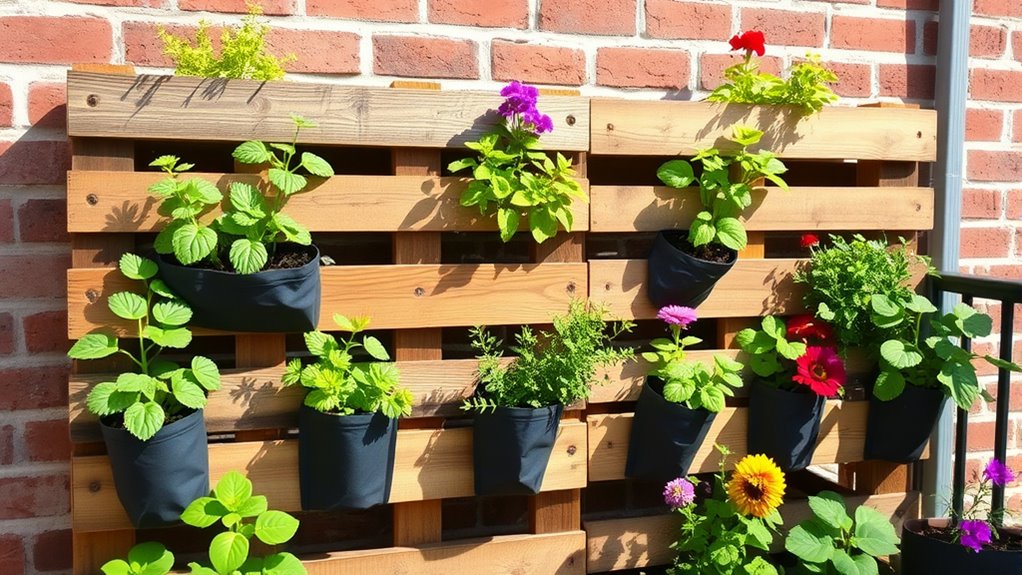
Have you considered how to create secure, planting-friendly pockets on your pallet? Installing landscape fabric is key. Start by cutting the fabric to twice the length of your pallet and fold it in half. This creates multiple planting pockets. Use a staple gun to attach the fabric firmly to the back of the pallet, making sure it extends into each cavity. Pull the fabric slightly to add slack, which helps contain the soil and prevents it from spilling out. Shape the fabric into individual pockets by creating folds or pleats, matching the depth of your pallet cavities. Ensure the landscape fabric is porous, allowing water to drain while holding soil in place. Properly fabric tension is essential to prevent sagging and maintain the integrity of your planting pockets. Additionally, choosing waterproof or breathable fabrics can help improve moisture retention and drainage. Making sure your fabric is compatible with plant roots encourages healthy growth and prevents waterlogging. Using drainage holes or channels can further enhance water flow and prevent root rot, promoting healthier plants. To further enhance the stability of your pockets, consider adding supportive edging to keep the fabric in place during watering or windy conditions. This method keeps your planting pockets stable and promotes healthy root growth.
Filling the Compartments With Quality Potting Soil
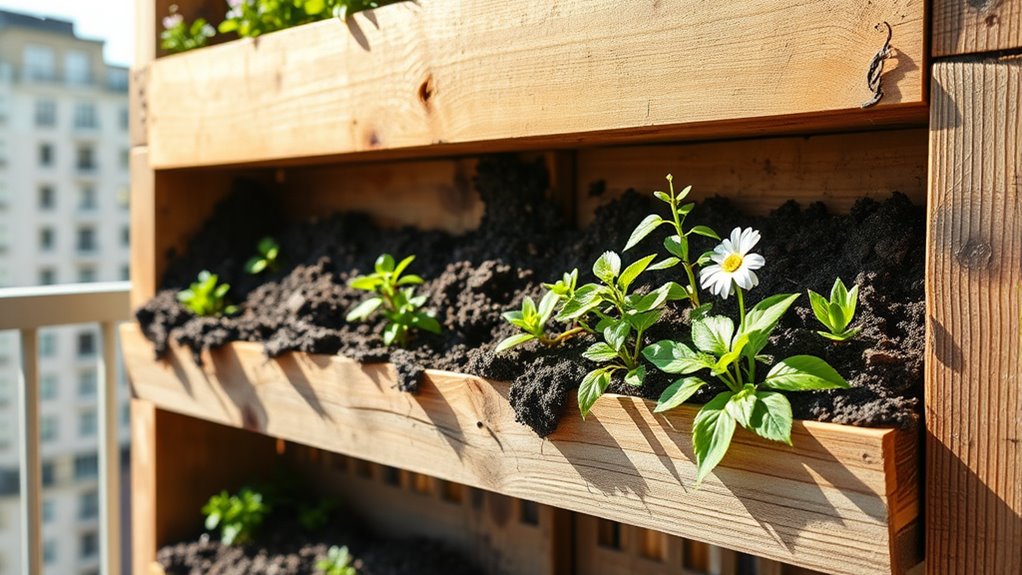
Filling each fabric pocket with high-quality potting soil is essential for healthy plant growth. Use a well-draining, nutrient-rich mix that includes compost or worm castings to give your plants the best start.
Make sure the soil reaches the top of each pocket to support strong root development, but avoid overfilling to prevent spillage and allow room for root expansion. Gently firm the potting mix after filling to eliminate air pockets and provide stability for transplanted plants.
Once filled, water the soil thoroughly to settle it in place and minimize transplant shock. Proper potting guarantees your vertical garden will thrive, offering healthy, vibrant plants that flourish in their new environment.
Choosing the Right Plants for Vertical Growth
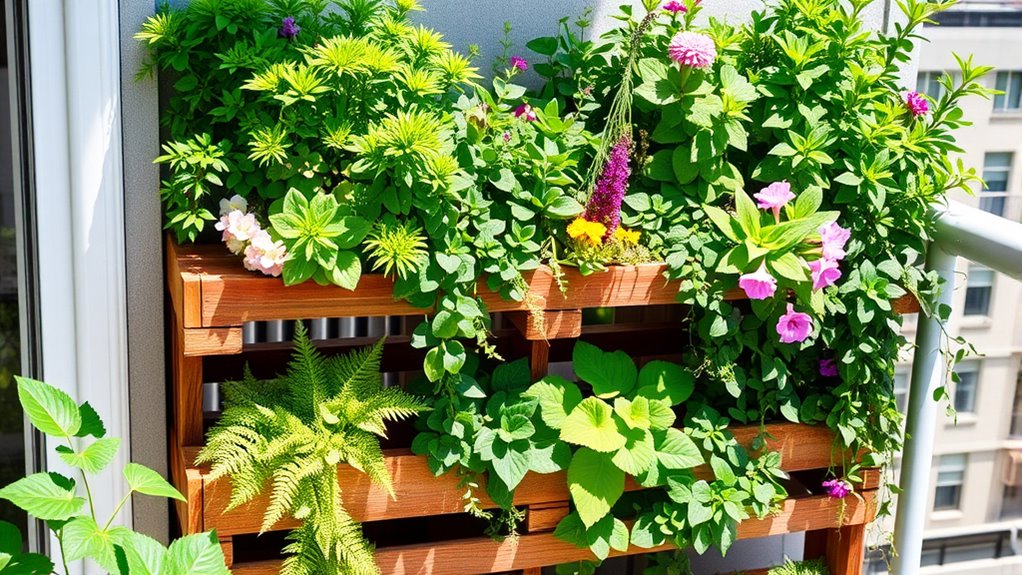
Choosing the right plants for your vertical garden involves selecting varieties that can thrive in limited soil and space. You want plants that grow well with shallow roots, like herbs, lettuce, or small flowering plants, which need good drainage.
Select plants that are lightweight and suited for confined environments, such as succulents, spinach, and miniature flowers. It’s essential to pick plants with similar water and sunlight needs to ensure uniform growth and easier maintenance.
Imagine vibrant herbs like parsley and thyme, or colorful blooms like calendula, thriving side by side. Prioritize perennial herbs like rosemary and oregano, which return each season and flourish in small soil pockets.
Transplanting and Arranging Your Vegetation
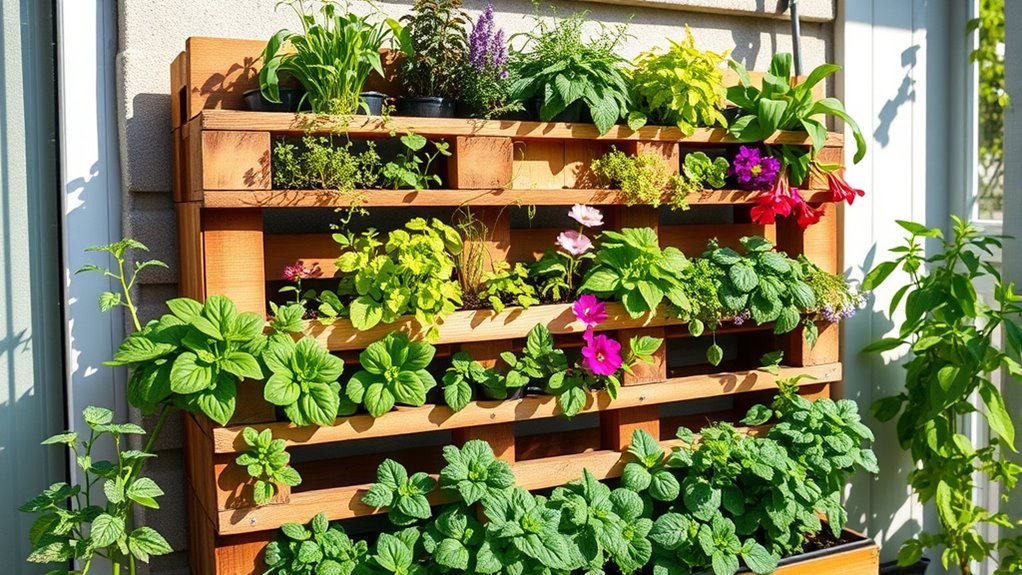
Once you’ve transplanted your seedlings into the pallet’s soil pockets, it’s important to arrange them thoughtfully based on their sunlight and watering needs.
During transplanting, gently remove each seedling from its nursery pot, planting it at the same depth in the soil-filled pockets to ensure good root contact. Remove any damaged or overly large leaves to reduce stress, but leave enough to support photosynthesis.
After transplanting, water each plant thoroughly to settle the soil and minimize transplant shock. Keep the soil consistently moist, and space your plants to prevent overcrowding, allowing airflow and room for growth.
Place high-water-demand plants like mint and coriander lower in the pallet for easier access, and consider companion planting to promote healthy development.
Maintaining Moisture and Nutrients for Healthy Plants
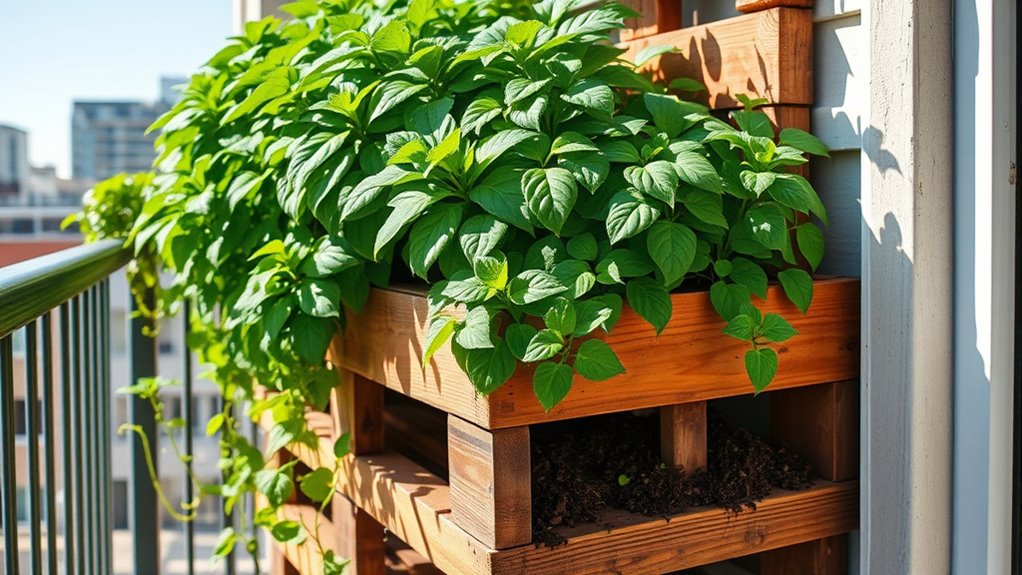
To keep your plants healthy, you need to manage soil moisture carefully by checking the top inch and watering when it feels dry.
Incorporate organic fertilizers or compost to provide steady nutrients without overwatering, and use mulching techniques to reduce evaporation.
Adjust your watering habits based on weather conditions to make sure your garden stays consistently moist and well-fed.
Soil Moisture Control
How can you guarantee your vertical pallet garden stays healthy and vibrant? The key is consistent soil moisture. Vertical gardens dry out quickly due to exposure and drainage, so regular watering is essential.
To improve soil moisture control, consider:
- Applying organic mulches like sugarcane mulch to retain water and reduce evaporation.
- Using soil wetting agents to enhance water penetration and even distribution.
- Choosing high-quality, water-retentive potting mixes with compost for better moisture retention and nutrient supply.
Regularly check the soil’s moisture level to avoid over- or underwatering. This helps promote healthy roots and prevents stress on your plants.
Proper soil moisture management ensures your vertical garden remains lush and thriving over time.
Organic Nutrient Sources
Ever wonder how to keep your vertical pallet garden both nutrient-rich and moisture-balanced? Organic amendments like sheep manure, worm castings, and spent coffee grounds are excellent for naturally providing essential nutrients. Mix these into your soil to boost fertility and support healthy plant growth.
You can also use water-soluble compost teas or liquid organic fertilizers to give your plants an extra nutrient boost.
Mulching with sugarcane mulch or organic compost helps retain moisture, regulate soil temperature, and releases nutrients slowly over time.
To improve water retention, consider adding soil wetter agents, especially during dry periods.
Additionally, planting cover crops or companion plants can naturally replenish nutrients, fix nitrogen, and enhance your garden’s overall soil health.
These organic sources keep your garden thriving sustainably.
Mulching Techniques
Applying mulch around your plants is a simple yet effective way to keep your vertical pallet garden healthy. Mulching techniques help retain soil moisture, reduce evaporation, and provide essential nutrients as organic materials decompose.
Use a layer of sugarcane mulch or a mix of coffee grounds and composted leaves to enrich the soil and promote vigorous growth. A 5-7 cm thick layer also prevents weed growth by blocking sunlight, reducing competition for water and nutrients.
Mulch acts as an insulating barrier, protecting roots from temperature extremes and maintaining consistent soil temperatures. Regularly replenishing your mulch guarantees continuous moisture retention and nutrient supply, keeping your plants thriving.
Imagine a lush, vibrant garden with healthy roots protected by these simple mulching techniques.
Managing Pests and Encouraging Beneficial Insects
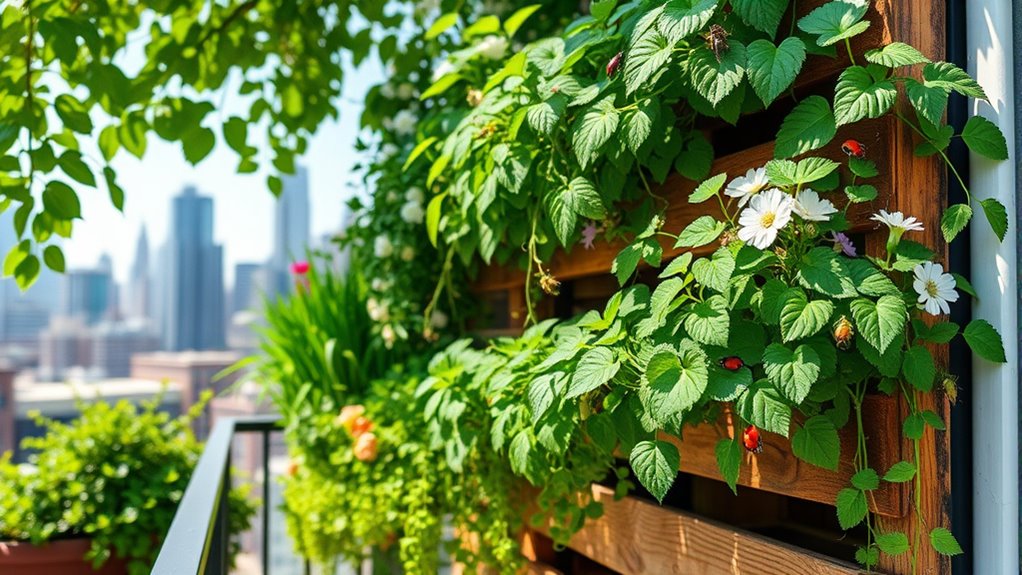
Managing pests in your vertical pallet garden is essential for healthy plants, but you can do so naturally by attracting beneficial insects. Planting diverse flowering plants like calendula and marigolds draws in ladybugs and hoverflies, which target common pests.
Herbs such as thyme, rosemary, and cilantro release aromatic compounds that repel aphids and whiteflies.
Incorporate natural barriers like mesh covers or row covers to shield your plants from pests while still allowing beneficial insects to access your garden.
Regularly remove infested leaves and debris to eliminate breeding sites for harmful insects.
Tips for Expanding and Customizing Your Balcony Garden
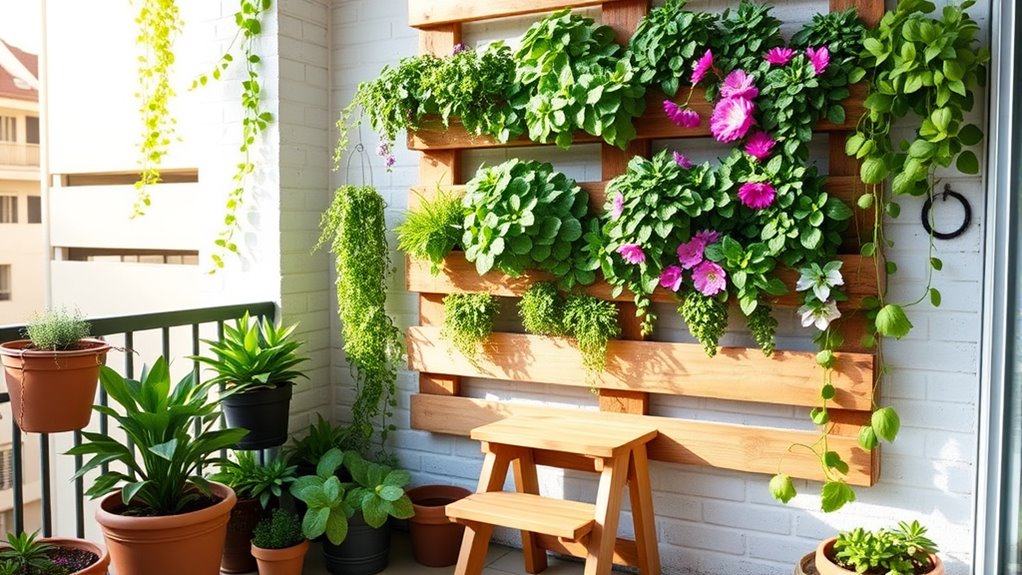
To make the most of your balcony space, consider expanding and customizing your vertical pallet garden with practical and creative solutions. Make sure to use multiple pallets or combine them vertically to increase planting capacity in limited space.
Maximize your balcony by expanding and customizing your vertical pallet garden creatively and practically.
You can also personalize your garden by painting or decorating pallets with weatherproof paint that matches your balcony’s aesthetic.
Incorporate a drip irrigation or self-watering system to efficiently water your plants across the expanded setup, saving time and effort.
To maximize space and visual interest, add small shelves, hooks, or trellises for climbing plants or hanging containers. These additions not only optimize space but also create a lush, personalized oasis that reflects your style and gardening goals.
Frequently Asked Questions
How to Build a Vertical Pallet Garden?
To build a vertical pallet garden, start by removing unnecessary slats with a hammer or pry bar.
Cut landscape fabric twice the length of the pallet, fold, and staple it onto the back to create planting pockets.
Make certain the pockets are deep enough, fill them with soil, and secure the fabric with a staple gun.
This setup ensures good drainage and enough space for your plants to thrive.
What to Line a Pallet Planter With?
You should line your pallet planter with landscape fabric. It keeps soil from falling out while allowing water to drain efficiently.
Cut the fabric into strips twice the length of each cavity, fold, and staple it securely to the back of the pallet.
Make sure the pockets are deep enough for ample soil. This porous fabric helps excess water escape and keeps your plants healthy.
Is It Safe to Make Raised Beds From Pallets?
You’re asking if creating raised beds from pallets is safe, like building a sturdy ship to sail your garden dreams. The answer depends on your choices: pick pallets labeled “HT” or “MB,” avoiding those with harmful chemicals or damage.
Always clean, seal, and inspect your pallets carefully. When you choose safe, untreated pallets, you’re laying a strong, chemical-free foundation for healthy, thriving plants on your balcony.
How to Make a Small Garden Out of Pallets?
To make a small garden out of pallets, start by selecting a sturdy, undamaged pallet. Remove unnecessary slats.
Then cut landscape fabric to twice the length of the pallet and staple it onto the back.
Fill the fabric pockets with potting soil, and plant herbs, vegetables, or flowers.
Water regularly and maintain your plants for a thriving, space-efficient garden that fits perfectly on your balcony.
Conclusion
With patience and passion, you’ll perfect your personalized pallet paradise. By blending bold blooms with clever crafts, you create a captivating corner that cultivates calm and charm. Keep nurturing your nurturing nature, steering pests with precision, and expanding your eco-friendly enclave. Your balcony becomes a beautiful, blossoming balcony boutique—an inspiring, inviting oasis that showcases your sustainable spirit and savvy skills. Start small, stay dedicated, and see your stunning sanctuary swiftly flourish.



